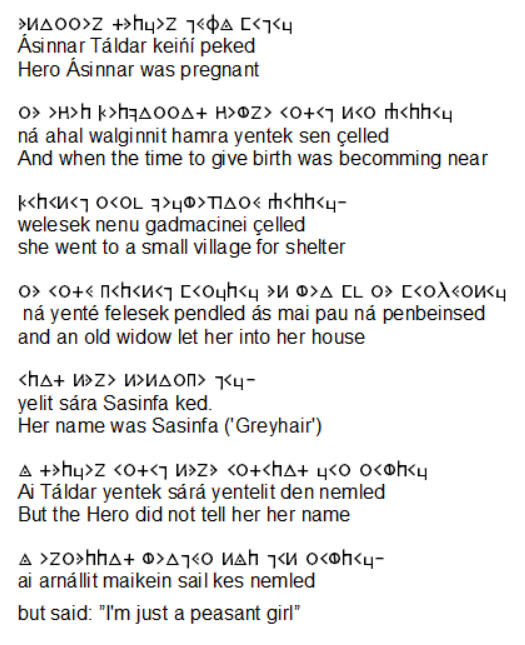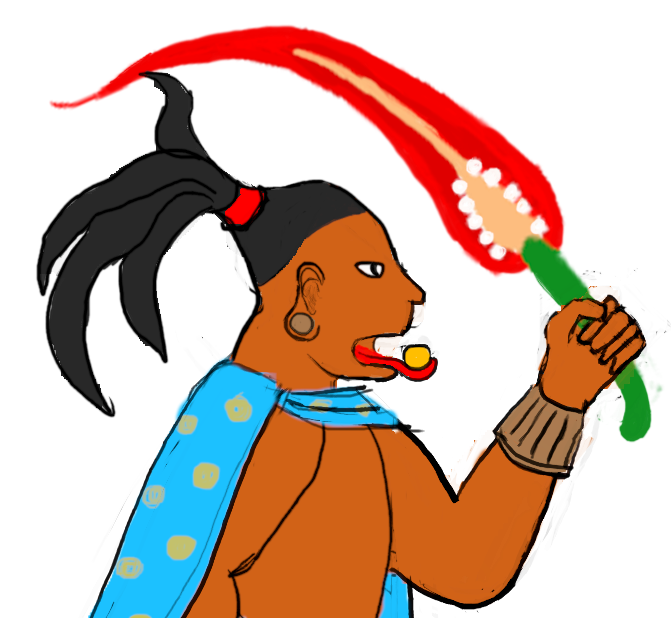Nem (Faren language)
Go back to the Languages of Salan!
Nem is the native language of the Farens of Farensal, but it is also used widely as the common language all over the Southern Continent.
Nem is distantly related to Aradal.
Sosiolinguistics
Nem is the most widely spoken language on Salan. Nem is the major prestige language of the Southern Continent, and in addition to the native speaking community, it is also widely studied by the learned people of the surrounding nations.Much of Nem's prestige stems from the speakers' control of the fertile farmland of the river valleys, which promoted quick population growth and wealth, but Nem speaking culture has also had a great impact on its surroundings. The Nem alphabet was the first writing system that was invented, and literacy in Nem spread the Faren culture widely.
Writing System
According to the myths, the Nem script was gifted to the people by the God Naruseiń, who revealed the skill of writing to the people of Fares.
Symbols
Because the script was developed specifically for Nem, the system is fairly regular and well suited to writing in Nem. There are 22 main letters that represent vowels and consonants. In addition, diacritics are used to mark the long vowelsUsage
The Nem script is the most widely used writing system on Salan. It is used for writing the Nem variants, and also for other primary languages of the continent such as Aradal and Tasal language and it has yielded many variations, such as the zeribian abjad. However, the literacy rate of the population is low, and the most of the commoners especially in the countryside can't read or write.Variations
The example text here is written in the monumental font, intended to be carved on stone or otherwise used for public display. In the handwriting version of the script the letter shapes are more round, and they are written partially connected.Example text
The following is an excerpt from the beginning of the tale of the Heroes Daursan and Kauteirin.Punctuation
The words are usually separated by a small space. The sentences can be separated with either a long line or with a dot, but there is a huge variation in if and how punctuation is used.Phonology
Vowels
i ɛ a u ɔ (written as /ieauo/)Long vowels: í, é á ú ó
Diphtongs: ai, ei, oi, ui, au
Consonants
| bilabial | alveolar | palatal | velar | |
|---|---|---|---|---|
| nasal | m | n | ń | |
| stop | p b | t d | k g | |
| fricative | f | s | ɕ~ç | h |
| approximant | w | l | y | |
| other | affricate: c (t͡s) | trill: r |
Nem also resists long sequences of alternating consonants and short vowels (CVCVCV). Thus Proto-Ara-Faren words such as arama 'bad' and balama 'fat' are rendered in Nem as arma and balma (compare to Aradal aräm and waläm )
Morphology
Verbs
The verbs have 3 tenses: preterite, present and future, and 3 persons. The verb also agrees in number, but the similarity between 2nd and 3rd person suffixes (ń, n) and the plural suffix (n) has made explicit plural marking disappear in some verb and dialects.In addition to the indicative stem, the verbs also have a so-called long stem, which is identical to the imperative form. The long stem is used to conjugate the verb in some subordinate clauses. Due to the sound changes that have happened in Nem, the difference is usually no longer in the lenght of the vowels but in quality, as we see with mauńa -> muińu The conjugation of mauńa 'to wash'
Nouns
The nem nouns have 7 cases and two numbers, singular and plural.The nouns belong to either of two main declension classes, named by the plural endings: n-class (animate nouns), or a-class (inanimate nouns).
Declension of A1-class nouns
| singular | plural | meaning | |
|---|---|---|---|
| nominative | far | faren | human |
| accusative | fare | fareni | human (object) |
| possessive | farim | farenim | human's |
| dative | faret | farenek | to a human |
| locative | fares | farenes | in/at a human |
| ablative | farei | farenei | from a human |
| comitative | fallit | farennit | with a human / related to human |
Run ante ás-á yarsa-d!
Dog(NOM) that I-ACC bite-PST
'That dog bit me!'
The possessive case is used for marking the owner:
Yai-n Alten, silmu hamr-at ás-im felin-et çeille!
holy.PL lord.PL night time.DAT I.POSS house.DAT come.IMP
'Dear Lords, come to my house for the night!'
The Locative, dative and ablative cases are used for marking the location. Locative marks the general location:
Fenér cana-s ke-n.
sailor boat.LOC be-3.PRES
'The sailor is on the boat'
Dative marks the movement towards a location:
Yain Alten, silmu hamr-at ás-im felin-et çeille!
holy lord.PL night time.DAT I.POSS house.DAT come.IMP
'Dear Lords, come to my house for the night!'
Ablative marks the movement away from a location:
ná Kur-ú béce-d sal-ei yé-s alte ked
and Cyrus.ACC call.PST.3 land-ABL that.LOC lord be-PST.3
'And he called Cyrus away from the land where he was ruling'
The comitative-instrumental case marks many of the remaining relationships between nouns. It behaves like genitive where there is no literal possession ("spirits OF the forest", even though the forest does not own the spirits):
Sawa-lit áda-n Kauteirin-et nemme-d-en
Forest-COM spirit.PL Kauteirin-DAT speak-PST-PL
‘The spirits of the forest spoke to Kauteirin’
It also marks with whom of with what tool something is done:
Sasinfa-lit say keińi-n kein nemliní yonu-d-an
Sasinfa-COM two child-PL be.IRR to.speak hear-PST-PL
‘They heard a word that two sons were living with Sasinfa’
Adjectives
Adjectives of Nem have both verbal and noun-like properties. The adjectives agree with the nouns in number, but not in case:kein çar 'a small child'
keińin çara 'the small children'
keińek çar 'to a small child'
keińinek çara 'to the small children'
The adjectives don't require copula (be-verb) like nouns:
kein ren ken 'the child is a man (male)'
kein çare 'the child is small'
kein tálad 'the child is dead / the child died / the dead child'
Adjectives ending in consonants have verbal forms ending in a vowel (ul->ulu):
Des faidu felet ul 'I don't like a dark house'
Feleses ulu 'my house is dark'
Syntax
N GEN toitu astim 'my rabbit'
N AP toitu sasse 'white rabbit'
N DEM toitu ente 'this rabbit'
NP ADP savas serme 'in the middle of forest' (literally: forest-in middle)
Questions
Interrogative clauses have the normal word order. Polar question (yes/no) are formed with the interrogative prefix an:
Pend-í an-mauńa-n? 'Did you wash your hands?' (literally: hand-ACC Q-wash-you) Content questions usually have both the interrogative prefix and the question word:
Çaurinnit, násal sallinfeles an-ken?
sorry where bathroom Q-is
'Excuse me, where is the toilet?'








Psyched to have discovered his after clicking through via your comment on my language Lüota for WorldEmber. I'm adding this to my reading list for after I finish judging the Tradition articles, but I can already tell it's going to help me polish my language articles in the future.
Thanks, glad to be of inspiration! ^^ Nem is my super long-term project, it has existed in some form from 2006 is think, when I was only 12!
I have a personal project of going through all the language articles from WE even though I'm not a judge, it's fun to see what all the others have been up to!